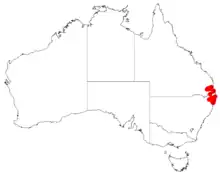Acacia baeuerlenii
Acacia baeuerlenii is a shrub of the genus Acacia and the subgenus Plurinerves that is endemic to a small area in eastern Australia.
| Acacia baeuerlenii | |
|---|---|
.jpg.webp) | |
| Acacia baeuerlenii flowering in D'Aguilar National Park. | |
| Scientific classification | |
| Kingdom: | Plantae |
| Clade: | Tracheophytes |
| Clade: | Angiosperms |
| Clade: | Eudicots |
| Clade: | Rosids |
| Order: | Fabales |
| Family: | Fabaceae |
| Subfamily: | Caesalpinioideae |
| Clade: | Mimosoid clade |
| Genus: | Acacia |
| Species: | A. baeuerlenii |
| Binomial name | |
| Acacia baeuerlenii | |
 | |
| Acacia baeuerlenii occurrence data from Australasian Virtual Herbarium | |
Description
The shrub has slender habit and typically grows to a height of 1 to 4 m (3 ft 3 in to 13 ft 1 in) and has angled, ribbed and hairy branchlets. Like most species of Acacia it has phyllodes instead of true leaves. The evergreen and ascending phyllodes usually have a narrowly elliptic and are straight to slightly incurved. The glabrous phyllodes are 6.5 to 15 cm (2.6 to 5.9 in) in length and 4.5 to 13 mm (0.18 to 0.51 in) in width and have multiple distant main nerves.[1] It blooms between June and August producing simple inflorescences in group of one to three along an axillary axis with a length of 1 to 10 mm (0.039 to 0.394 in). The spherical flowerheads have a diameter of 6 to 11 mm (0.24 to 0.43 in) and contain 30 to 40 white to cream-coloured flowers. Following flowering it produces hairy and leathery seed pods that are straight or occasionally twisted. The straight sided pods are 6 to 10 cm (2.4 to 3.9 in) in length and 6 to 8 mm (0.24 to 0.31 in) wide and have the seeds inside are arranged longitudinally.[2] The dull dark brown seeds have a broadly oblong-elliptic shape with a length of 5 to 5.5 mm (0.20 to 0.22 in) and a thick and fleshy aril.[1]
Taxonomy
The species was first formally described in 1896 by the botanists Joseph Maiden and Richard Thomas Baker as part of the work Descriptions of some new species of plants from New South Wales as published in the Proceedings of the Linnean Society of New South Wales. It was reclassified as Racosperma baeuerlenii in 1987 by Leslie Pedley then transferred back to genus Acacia in 2001. The only other synonym is Acacia baeuerleni.[3] The specific epithet honours William (Wilhelm) Baeuerlen who collected the type specimen. It is similar in appearance to Acacia tessellata and Acacia venulosa.[2]
Distribution
The range of the plant extends from around Maclean and north of Red Rock and the Gibraltar Range[2] in the north eastern New South Wales in the south up to around Helidon in south-eastern Queensland in the north. It is often sandy soils as a part of dry sclerophyll forest communities.[1]
See also
References
- "Acacia baeuerlenii". Wattle - Acacias of Australia. Lucid Central. Retrieved 21 September 2020.
- "Acacia baeuerlenii Maiden & R.T.Baker". PlantNet - The Flora of New South Wales. Royal Botanic Gardens, Sydney. Retrieved 23 September 2020.
- "Acacia baeuerlenii Maiden & R.T.Baker". Atlas of Living Australia. Global Biodiversity Information Facility. Retrieved 23 September 2020.